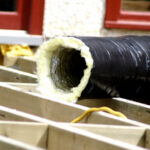If you are thinking of attempting basement insulation, then getting the right information on the most suitable kind of insulating product to use and the right way to install it is very important. The basement is an area of the home where in cold locations can cause significant heat loss if not insulated. Because basements are generally below ground level they may be prone to water seepage, poor drainage, cold air and other problems. The right insulation can help to control many of these problems especially if the initial installation is done in the correct way. Interior installation of an insulating product is generally a fairly straightforward process, but if you are unsure it may be wise to find someone else who has attempted it so you will know if there are any pitfalls, otherwise you can have a contractor do it for you. Find out if there are any building requirements which cover interior insulation in your area, as batt and foam insulation is required to be covered with a drywall type product because of fire codes, and the installation will need to pass an inspection.
Before purchasing any basement insulation you will need to ascertain what R-Value rating (or heat resistance loss) you may require in your basement. The ratings fall between R-5 and R-10, and you will need to purchase insulation within this range for your project. You will generally need the following tools: safety glasses, protective clothing, respirator or dust mask, 3/8″ or ½” staples and a stapler, either standard, electric or hammer variety. You will also need a light to work by, an extension cord, a tape measure, step ladder and something to cut the insulation such as a utility knife plus spare blades. Next you may require, but this could depend on what type of insulation you are using: caulking gun and caulk, expanding foam sealant, ½” gypsum drywall, chalk line, duct tape, white vinyl tape, 2 x 2 timber, extruded polystyrene foam and construction adhesive. You may also require a power activated gun plus fasteners, noise protection for your ears, wire insulation hangers, asphalt roofing cement, drill and a carbide drill bit and masonry screws.
Once you know what basement insulation you will be using you will then be able to purchase this from your supplier. Installing the insulation will depend on what kind you have decided to purchase as different types of insulation will require different methods of attachment. Some methods apply an adhesive to attach the insulation to the walls and ceiling but the adhesive used will depend on the amount of moisture occurring on the walls. Other types of insulation require a covering of fire resistant drywall or another similar product over the insulation. Batts often require blanket insulation to cover the joins because of problems with cold seeping through the areas where the batts meet on the walls and ceiling. So once you know what kind of insulation you are putting into your basement, get the proper instructions on the correct method of applying them so your project will be a success.



